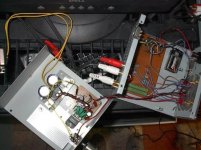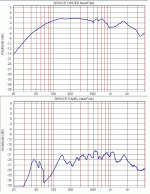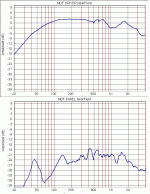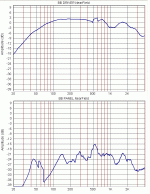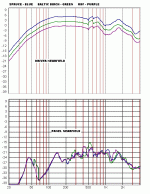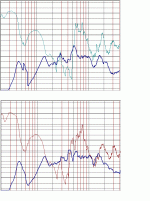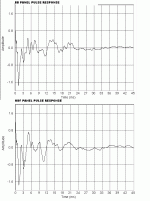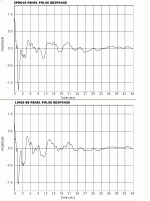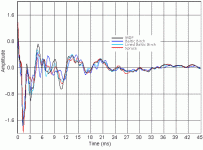If I can suggest the measurements procedure, try to do equal measurements: first the NF of the 3 boxes; then the side pannels of the 3; then the back pannels.
Before each measurement do a break-in sweep for some minutes, than wait 1 minute to cool down, then do the measurement. Repeat the same procedure every time you switch box.
It would be nice to screw the drive with the same force on each box, should be the torsiometer the tool to do the job.
Before each measurement do a break-in sweep for some minutes, than wait 1 minute to cool down, then do the measurement. Repeat the same procedure every time you switch box.
It would be nice to screw the drive with the same force on each box, should be the torsiometer the tool to do the job.
Thanks for the advise Claudio, and I appreciate your interest in this.
As I write this, all of the tests are done, I'm compiling the data and presenting it here. I have done the tests as consistantly as possible, being carefull to position everything in the same way for each box.
I only tested the drivers nearfield and the side panels nearfield. I didn't consider testing the back, as I assumed it would see the same forces as the side panel, and also it's slightly narrower.
The overall purpose of the experiment was to assess the impact of various materials on speaker sound quality. If baltic birch plywood gives superior sonic results, it should be apparent in the test results.
Torque on the screws is fairly consistant, as I used a cordless driver with the clutch set low. With that said, each material holds the screws differently, but I believe in the end this had little effect.
Shortly I will start to post the results, was just hopefull of an appearance of this threads creator, our esteemed moderator.
Dave, you go camping?
The "guts" of my jig:
As I write this, all of the tests are done, I'm compiling the data and presenting it here. I have done the tests as consistantly as possible, being carefull to position everything in the same way for each box.
I only tested the drivers nearfield and the side panels nearfield. I didn't consider testing the back, as I assumed it would see the same forces as the side panel, and also it's slightly narrower.
The overall purpose of the experiment was to assess the impact of various materials on speaker sound quality. If baltic birch plywood gives superior sonic results, it should be apparent in the test results.
Torque on the screws is fairly consistant, as I used a cordless driver with the clutch set low. With that said, each material holds the screws differently, but I believe in the end this had little effect.
Shortly I will start to post the results, was just hopefull of an appearance of this threads creator, our esteemed moderator.
Dave, you go camping?
The "guts" of my jig:
Attachments
Without further ado... the results:
Box #1: Spruce sheating. Probably the least suitable material for speaker construction. Warped, rough, full of voids and knots. Not particularly strong or stiff. I included it here to put things into perspective. How does such an obviously inferior material measure up?
The chart on the top shows driver nearfield mounted in this box. Compare this to the chart posted earlier from Vifa. Not a bad match, considering the driver is mounted in a small sealed box.
The bottom chart is the panel nearfield measurement. Note the dB levels of each chart, the highers peak in the panel measurement coming at 500-600 Hz, not quite reaching -18 dB.
Box #1: Spruce sheating. Probably the least suitable material for speaker construction. Warped, rough, full of voids and knots. Not particularly strong or stiff. I included it here to put things into perspective. How does such an obviously inferior material measure up?
The chart on the top shows driver nearfield mounted in this box. Compare this to the chart posted earlier from Vifa. Not a bad match, considering the driver is mounted in a small sealed box.
The bottom chart is the panel nearfield measurement. Note the dB levels of each chart, the highers peak in the panel measurement coming at 500-600 Hz, not quite reaching -18 dB.
Attachments
Box #2: MDF. Much maligned by Dave as being a life-sucking material that will bury all of the sweet low level information in the music by emiting a steady stream of noise. Surely the deficiences of this material will immediately apparent?
Once again the charts, top - driver nearfield, bottom - panel nearfield. The strongest peak for this material is actually 2, between 400 and 600 Hz just slightly exceeding -18 dB. Several re-tries of this test yielded the same double hump result. Still, at 21 dB below the peak output of the driver it's debateable whether this will be heard.
Once again the charts, top - driver nearfield, bottom - panel nearfield. The strongest peak for this material is actually 2, between 400 and 600 Hz just slightly exceeding -18 dB. Several re-tries of this test yielded the same double hump result. Still, at 21 dB below the peak output of the driver it's debateable whether this will be heard.
Attachments
Box #3: Baltic birch plywood. According to some, the ultimate material for speaker construction. Highly regarded by all of us for it's superior strenght, stiffness, and sonic qualities. This will annihilate the other contestants!
Finally, I get to show what a premium material measures like.
The charts, as before, top - driver nearfield, bottom - side panel nearfield.
Disappointed? I was surprised to see that there was not much of a difference between this and the others, and in fact this test worse, consistantly hitting the -15 dB mark. I re-tested several times with the same result.
Finally, I get to show what a premium material measures like.
The charts, as before, top - driver nearfield, bottom - side panel nearfield.
Disappointed? I was surprised to see that there was not much of a difference between this and the others, and in fact this test worse, consistantly hitting the -15 dB mark. I re-tested several times with the same result.
Attachments
Conclusion: based on the tests, the difference between materials as far as sound colouration goes, is minimal. If my test equipment cannot detect a significant difference, then how will the human ear? Indeed, based on the results, we should all switch to cheap spruce plywood, as this had on average less noise output.
The following chart shows all of the results for each box colour coded and put together for critical comparison.
The following chart shows all of the results for each box colour coded and put together for critical comparison.
Attachments
Remember that during WW2, it was proven that you can hear up to 30db down into noise, and so all those boxes would be audible.
I suspect that the 'suckout' between the two peaks for the MDF, and the Spruce ply are what we hear. This implies a phase issue with the resonance, and most likely an inversion. That inversion will literally 'suck' out the music at that point. The BB doesnt seem to suffer that suck out, and whilst it may have an audible sonic signature, it is in phase, and so doesnt produce an obvious dip.
Just my thoughts on your graphs.
Owen
I suspect that the 'suckout' between the two peaks for the MDF, and the Spruce ply are what we hear. This implies a phase issue with the resonance, and most likely an inversion. That inversion will literally 'suck' out the music at that point. The BB doesnt seem to suffer that suck out, and whilst it may have an audible sonic signature, it is in phase, and so doesnt produce an obvious dip.
Just my thoughts on your graphs.
Owen
owen said:Remember that during WW2, it was proven that you can hear up to 30db down into noise, and so all those boxes would be audible.
I suspect that the 'suckout' between the two peaks for the MDF, and the Spruce ply are what we hear. This implies a phase issue with the resonance, and most likely an inversion. That inversion will literally 'suck' out the music at that point. The BB doesnt seem to suffer that suck out, and whilst it may have an audible sonic signature, it is in phase, and so doesnt produce an obvious dip.
I left out phase in the posted charts, but here they are for study, at least for MDF and BB. The phase relationship is the same as the response - very little deviation when overlayed.
No arguement about noise, but I didn't build these to be quite. The idea is to compare the sonic properties of the material, specifically panel vibration and the sound it produces.
Still and all, the sound that comes from the driver is virtually identical from each box. This is where any "sucking of the life" would be noticed.
Top chart is BB, bottom is MDF.
Attachments
planet10 said:decay plots?
dave
Sorry Dave, as Claudio says there is not a utility for spectral decay in speaker workshop.
Claudio, what program will convert the impulse results to CSD plots? Or would the impulse tests themselves give enough infomation on decay without conversion? At this point I would have to go back and run the impulse tests, as I didn't in the first place.
Barring the decay, Dave what are your opinions on my findings here? Ready to put this one to bed?
I run a couple of damping tests on the baltic birch box: with loose stuffing (pink fiberglass) and with the walls lined with my rubber backed carpet. Will post those results shortly.
MJL, actually to do a NF measurement you did an impulse response: if you haven't saved each IR you have to redo all the measurement, to get CSD or else.
My suggestion: use ARTA whose demo mode allows you to save the picture of the measurement; with ARTA you can calculate the CSD, the step response, so just repeat the measurements with this program, if you like, the calibration procedure is pretty quick.
Other program option, that I know, are Loudspeaker Lab, Praxis but I don't know what the demo mode allows.
My suggestion: use ARTA whose demo mode allows you to save the picture of the measurement; with ARTA you can calculate the CSD, the step response, so just repeat the measurements with this program, if you like, the calibration procedure is pretty quick.
Other program option, that I know, are Loudspeaker Lab, Praxis but I don't know what the demo mode allows.
claudio said:MJL, actually to do a NF measurement you did an impulse response: if you haven't saved each IR you have to redo all the measurement, to get CSD or else.
I just did the pulse measurements for each box, and will post those results (which are just in graph form, but should give a good indication of decay for each material).
As far as installing Arta for this purpose, I resist. I have Speaker Workshop running and calibrated, and don't want to mess that up (took long enough to get that right). Besides, SW does everything I need it to do, and at this point, I know it's accurate.
Geoff H said:Arta will give CSD plots. I'm still getting a grasp on interpreting them.
30 dB is well inside our usual dynamic range. How much would you pay for an amp with a 30dB s/n ratio? Vinyl approached 60dB.
Impulse tests should show a difference.
Point taken about the noise level, but keep in mind all of the materials exhibited the same noise level.
Impulse test to be posted shortly.
As follows are the impuse charts for baltic birch and MDF. As can be seen, not a wild difference between the two. MDF has slightly higher peak amplitude within the first 12 ms, but quickly settles down. Decay time seems to be the same.
Note: Plot has been 1/6 octave smoothed.
Note: Plot has been 1/6 octave smoothed.
Attachments
Here is the pulse response for spruce, with an added bonus - pulse for the carpet lined BB box before I had to tear it all out to test the untreated panel.
Once again, spruce is looking pretty good, with overall lower amplitude than MDF, but with a sligtly longer decay time.
As can be seen, lining the panel with my carpet had next to no effect on amplitude or decay time. This was unexpected.
Once again, spruce is looking pretty good, with overall lower amplitude than MDF, but with a sligtly longer decay time.
As can be seen, lining the panel with my carpet had next to no effect on amplitude or decay time. This was unexpected.
Attachments
MJL21193 said:Barring the decay, Dave what are your opinions on my findings here?
FR doesn't tell us much. The impulse response should tell us more, but the results are hard to interpret.
Instead of smoothing, an average of a number of trials to reduce noise would give results that should remove some of the unknowns.
We also don't know how much of the impluse is panel & how much is speaker radiation wrapping around the panel.
dave
Attachments
planet10 said:
FR doesn't tell us much. The impulse response should tell us more, but the results are hard to interpret.
Instead of smoothing, an average of a number of trials to reduce noise would give results that should remove some of the unknowns.
We also don't know how much of the impluse is panel & how much is speaker radiation wrapping around the panel.
dave
How is that freq. response doesn't tell us much? It tells us what is available to be heard, and at what frequencies. The impulse results are what they are. My equipment, though not professional, is very accurate.
As for smoothing, it's necessary, as I am using a large sample size (132K) and there is in average - I have the repeat count set to 7. That's 7 times the sample rate averaged. I also ran the individual tests 3-4 times in a row to make sure the results are consistant.
Wrap around from the driver could be a possible influence, but as mentioned earlier, attempts to block it's output were of little impact. Mic placement for the panel impulse tests was less than 1/4" from the panel. Similar test for the driver at that distance and sound level would be off the scale of the chart.
- Status
- This old topic is closed. If you want to reopen this topic, contact a moderator using the "Report Post" button.
- Home
- Design & Build
- Construction Tips
- Discussion on what materials to build speakers out of
